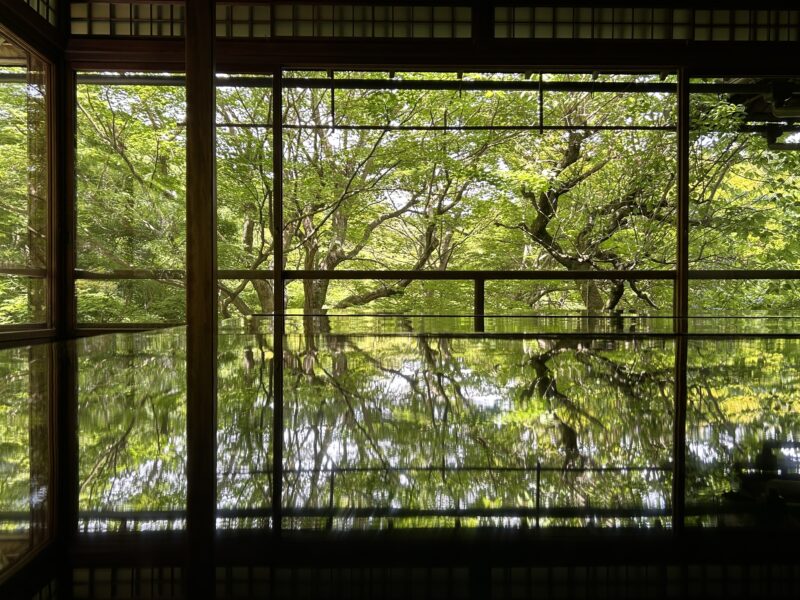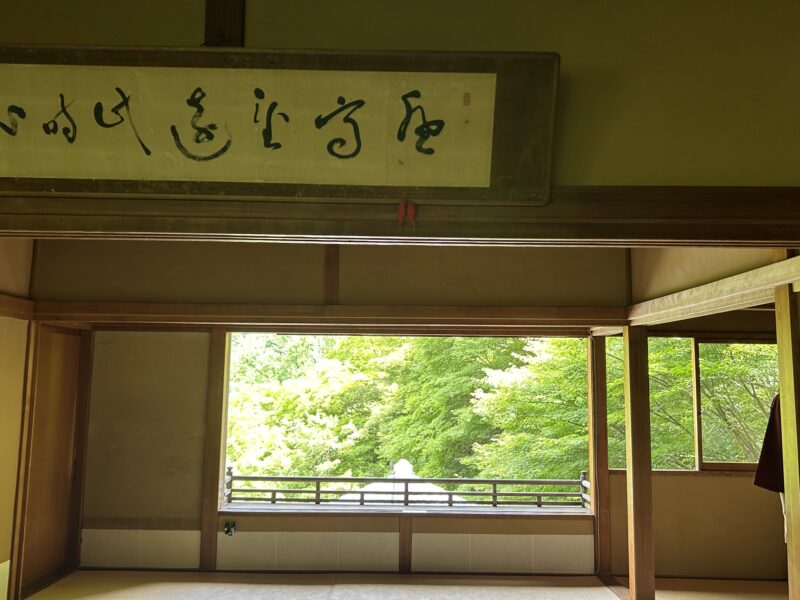
2024.07.08

写経机に映り込む紅葉が有名な瑠璃光院。
青紅葉が美しい季節も参拝するのにとても良いタイミングです。
季節に毎年、春・夏・秋の年三回特別公開され,春と夏は予約をせずに拝観できます。
五月末の平日に行ってきました。
ほとりからは京阪電車で出町柳まで行き、
叡山電鉄に乗り換えレトロな雰囲気のランプがぶら下がるかわいらしい雰囲気の八瀬口駅で降りると、
緑に囲まれ川の流れる音がに包まれ、山に来た!と感じます。
駅から徒歩10分程気持ちの良い道を歩いていくと瑠璃光院に到着です。






混雑しているタイミングには、門の前の待機場で順番を待ちますが、平日だったのですんなりと入れました。
門を入ってすぐに拝観料を払い、石段を上がっていきます。
途中苔の緑色が濃く美しく、この先にどんな風景が見られるのだろうかと期待が膨らみます。
滝があり、鯉が泳ぐ池を通り過ぎるといよいよ数寄屋造りの玄関に到着です。
参詣者が滞りなく流れるようにインカムを付けたスタッフが沢山おられ、
スムーズに書院二階へと案内されました。
あの有名な写経机に映り込んだ青紅葉と窓から見える実際の紅葉を撮影しようと、
皆さん譲り合いながら順番に一眼レフや携帯電話を写経机の手前に置き熱心にのぞき込んでいました。
私も少しだけ順番を待ち撮影をしました。鏡に映るかのように窓の外と同じ鮮やかさの緑色の机。
カメラ越しと、実際の青もみじを交互に見比べながら鑑賞しました。
それはとても贅沢は瞬間でした。写経をする人も多く、順番待ちの列が出来ていました。


写経机だけではなく、敷地内は全ての場所がとても美しく、
有料の抹茶席で瑠璃の庭に向かって静かに座りお茶を楽しまれたり、
床の間に飾られた室町時代の掛け軸やラピスラズリの石(瑠璃石)を見る方、
半分開けられた障子から庭の緑を撮影する方と
それぞれの参拝者があちこちで穏やかな時間を過ごされていました。
ゆっくりと色んな角度から楽しめる青もみじをしっかりと目に焼き付け、
濃い緑色が綺麗な苔を楽しみながら石段を降りました。
書院は二階建てで敷地内でも高低差があり、山を切り開いて建てられたといった印象を受けました。
緑に囲まれたお寺に行くと心が穏やかにやすらぎます。

瑠璃光院を満喫した後は、すぐ側にあるルイ・イカール美術館を無料で楽しむ事ができます。
立ち寄る参拝者が意外に少なく、広い大邸宅といった雰囲気の美術館です。
ルイ・イカール美術館のチラシを見かけ「こんな美術館があるの?初めて聞く!行ってみたい!」
と思ったのが今回の瑠璃光院参拝のきっかけでした。
華やかなパリジェンヌを描き続けた画家ルイ・イカールの作品だけを集めた美術館です。
竹林を借景にしたガラス窓に飾られた作品、それぞれの部屋のテーマごとに飾られた作品を
空間そのものを含めて楽しむことができます。
繊細なエッチングが手彩色で優しく優雅に描かれていて、気持ちも優雅になりました。
無料で入れるものの、協賛金(300円)を払うとコーヒーとビスケットをいただく事ができます。
広々とした庭を眺めながらギャラリーで飲むのもよし、竹の庭に向かいながら飲むのもよし。
ここでも瑠璃光院で感じたゆったりとした時の流れ、緑の美しさ、
静かな時を過ごす贅沢さを感じながら楽しむ事ができました。
瑠璃光院と合わせていくとお得感があります。是非こちらでもお過ごしください。



Rurikoin Temple is famous for the Japanese maple leaves reflected on the sutra table. The current season, when the green Japanese maple leaves are at their best, is also a very good time to visit the temple. The temple is open to the public three periods a year in spring, summer, and fall. In spring and summer, you can visit the temple without reservation.
I went on a weekday at the end of May. It takes about an hour from hotori. When I got off at Yaseguchi Station, which has a cute retro atmosphere with hanging lamps, surrounded by greenery and the sound of the river flowing. I felt that I was in the mountains!. A 10-minute walk along a pleasant path led me to Rurikoin Temple.
At busy times, visitors need to wait their turn in the waiting area in front of the gate, but since it was a weekday, I was able to enter without waiting. After entering the gate, I paid the entrance fee and walked up the stone steps. On the way up the stone steps, the moss was a beautiful, dark green color, and my anticipation grew as I wondered what kind of scenery I would see ahead. After passing a waterfall and a pond with carps swimming in it, I finally arrived at the entrance to the sukiya-style building.
There were many staff members wearing intercoms to ensure a smooth flow of visitors, and I was smoothly guided to the second floor.
Everyone took turns placing their SLR cameras and cell phones on the sutra table. The reflected green table was as vivid as the outside of the window, as if reflected in a mirror. I alternated between looking through the camera and looking at the actual green Japanese maples. It was a very luxurious moment.
Not only the sutra table, but also all the places in the temple are beautiful, and visitors can spend their time at their leisure: sitting quietly and enjoying Matcha tea facing the garden of lapis lazuli, looking at the Muromachi period hanging scroll and lapis lazuli stones displayed in the alcove, taking pictures of the greenery in the garden through the half-open shoji screens, etc.
The two-story building, with its different elevations even within the site, gave the impression that it was built by carving out a mountain. Visiting a temple surrounded by greenery is a peaceful and relaxing experience.

After enjoying Rurikoin Temple to the fullest, visitors can enjoy the Louis Icart Museum, located right next to the temple, free of charge. You can enjoy the paintings in a spacious mansion-like atmosphere.
This museum collects only the works of the artist who continued to paint gorgeous Parisiennes. Works are displayed in glass windows with a bamboo grove in the background. You can enjoy the works displayed in each of the rooms, including the space itself. The delicate etchings, gently and elegantly hand-colored, made me feel graceful.
Although admission is free, a sponsorship fee (300 yen) is required to get coffee and cookies. You can drink it in the gallery while admiring the spacious garden, or while facing the bamboo garden.
Here, too, you can experience the same relaxed flow of time and the beauty of the greenery that you felt at Rurikoin teple.
If you visit Rurikoin temple, I sincere hope you will spend your time at this museum as well.
Mikko


